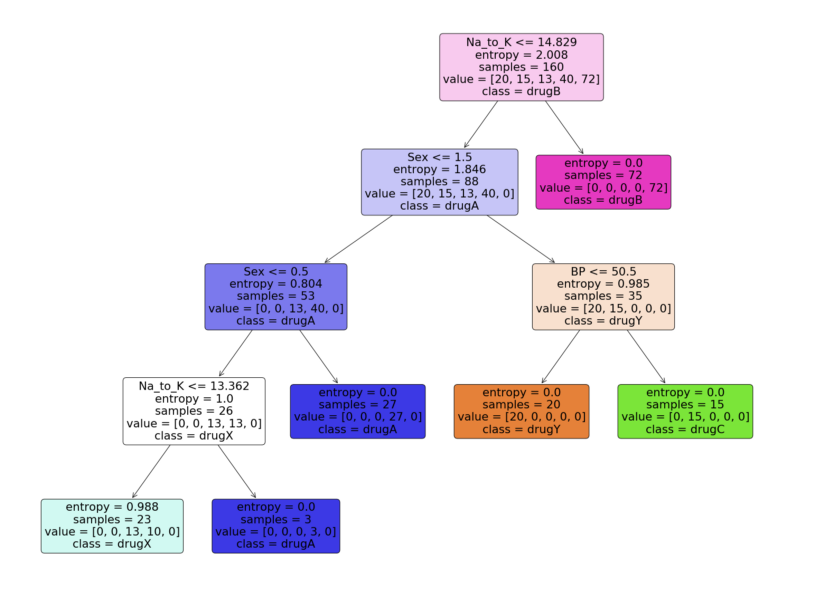用Python构建和可视化决策树
点击上方“小白学视觉”,选择加"星标"或“置顶”
重磅干货,第一时间送达
本文转载自:磐创AI
决策树
决策树是当今最强大的监督学习方法的组成部分。决策树基本上是一个二叉树的流程图,其中每个节点根据某个特征变量将一组观测值拆分。
决策树的目标是将数据分成多个组,这样一个组中的每个元素都属于同一个类别。决策树也可以用来近似连续的目标变量。在这种情况下,树将进行拆分,使每个组的均方误差最小。
决策树的一个重要特性是它们很容易被解释。你根本不需要熟悉机器学习技术就可以理解决策树在做什么。决策树图很容易解释。
利弊
决策树方法的优点是:
决策树能够生成可理解的规则。
决策树在不需要大量计算的情况下进行分类。
决策树能够处理连续变量和分类变量。
决策树提供了一个明确的指示,哪些字段是最重要的。
决策树方法的缺点是:
决策树不太适合于目标是预测连续属性值的估计任务。
决策树在类多、训练样本少的分类问题中容易出错。
决策树的训练在计算上可能很昂贵。生成决策树的过程在计算上非常昂贵。在每个节点上,每个候选拆分字段都必须进行排序,才能找到其最佳拆分。在某些算法中,使用字段组合,必须搜索最佳组合权重。剪枝算法也可能是昂贵的,因为许多候选子树必须形成和比较。
Python决策树
Python是一种通用编程语言,它为数据科学家提供了强大的机器学习包和工具。在本文中,我们将使用python最著名的机器学习包scikit-learn来构建决策树模型。我们将使用scikit learn提供的“DecisionTreeClassifier”算法创建模型,然后使用“plot_tree”函数可视化模型。
步骤1:导入包
我们构建模型的主要软件包是pandas、scikit learn和NumPy。按照代码在python中导入所需的包。
import pandas as pd # 数据处理
import numpy as np # 使用数组
import matplotlib.pyplot as plt # 可视化
from matplotlib import rcParams # 图大小
from termcolor import colored as cl # 文本自定义
from sklearn.tree import DecisionTreeClassifier as dtc # 树算法
from sklearn.model_selection import train_test_split # 拆分数据
from sklearn.metrics import accuracy_score # 模型准确度
from sklearn.tree import plot_tree # 树图
rcParams['figure.figsize'] = (25, 20)
在导入构建我们的模型所需的所有包之后,是时候导入数据并对其进行一些EDA了。
步骤2:导入数据和EDA
在这一步中,我们将使用python中提供的“Pandas”包来导入并在其上进行一些EDA。我们将建立我们的决策树模型,数据集是一个药物数据集,它是基于特定的标准给病人开的处方。让我们用python导入数据!
Python实现:
df = pd.read_csv('drug.csv')
df.drop('Unnamed: 0', axis = 1, inplace = True)
print(cl(df.head(), attrs = ['bold']))
「输出:」
Age Sex BP Cholesterol Na_to_K Drug
0 23 F HIGH HIGH 25.355 drugY
1 47 M LOW HIGH 13.093 drugC
2 47 M LOW HIGH 10.114 drugC
3 28 F NORMAL HIGH 7.798 drugX
4 61 F LOW HIGH 18.043 drugY
现在我们对数据集有了一个清晰的概念。导入数据后,让我们使用“info”函数获取有关数据的一些基本信息。此函数提供的信息包括条目数、索引号、列名、非空值计数、属性类型等。
Python实现:
df.info()
「输出:」
<class 'pandas.core.frame.DataFrame'>
RangeIndex: 200 entries, 0 to 199
Data columns (total 6 columns):
# Column Non-Null Count Dtype
--- ------ -------------- -----
0 Age 200 non-null int64
1 Sex 200 non-null object
2 BP 200 non-null object
3 Cholesterol 200 non-null object
4 Na_to_K 200 non-null float64
5 Drug 200 non-null object
dtypes: float64(1), int64(1), object(4)
memory usage: 9.5+ KB
步骤3:数据处理
我们可以看到像Sex, BP和Cholesterol这样的属性在本质上是分类的和对象类型的。问题是,scikit-learn中的决策树算法本质上不支持X变量(特征)是“对象”类型。因此,有必要将这些“object”值转换为“binary”值。让我们用python来实现
Python实现:
for i in df.Sex.values:
if i == 'M':
df.Sex.replace(i, 0, inplace = True)
else:
df.Sex.replace(i, 1, inplace = True)
for i in df.BP.values:
if i == 'LOW':
df.BP.replace(i, 0, inplace = True)
elif i == 'NORMAL':
df.BP.replace(i, 1, inplace = True)
elif i == 'HIGH':
df.BP.replace(i, 2, inplace = True)
for i in df.Cholesterol.values:
if i == 'LOW':
df.Cholesterol.replace(i, 0, inplace = True)
else:
df.Cholesterol.replace(i, 1, inplace = True)
print(cl(df, attrs = ['bold']))
「输出:」
Age Sex BP Cholesterol Na_to_K Drug
0 23 1 2 1 25.355 drugY
1 47 1 0 1 13.093 drugC
2 47 1 0 1 10.114 drugC
3 28 1 1 1 7.798 drugX
4 61 1 0 1 18.043 drugY
.. ... ... .. ... ... ...
195 56 1 0 1 11.567 drugC
196 16 1 0 1 12.006 drugC
197 52 1 1 1 9.894 drugX
198 23 1 1 1 14.020 drugX
199 40 1 0 1 11.349 drugX
[200 rows x 6 columns]
我们可以观察到所有的“object”值都被处理成“binary”值来表示分类数据。例如,在胆固醇属性中,显示“低”的值被处理为0,“高”则被处理为1。现在我们准备好从数据中创建因变量和自变量。
步骤4:拆分数据
在将我们的数据处理为正确的结构之后,我们现在设置“X”变量(自变量),“Y”变量(因变量)。让我们用python来实现
Python实现:
X_var = df[['Sex', 'BP', 'Age', 'Cholesterol', 'Na_to_K']].values # 自变量
y_var = df['Drug'].values # 因变量
print(cl('X variable samples : {}'.format(X_var[:5]), attrs = ['bold']))
print(cl('Y variable samples : {}'.format(y_var[:5]), attrs = ['bold']))
「输出:」
X variable samples : [[ 1. 2. 23. 1. 25.355]
[ 1. 0. 47. 1. 13.093]
[ 1. 0. 47. 1. 10.114]
[ 1. 1. 28. 1. 7.798]
[ 1. 0. 61. 1. 18.043]]
Y variable samples : ['drugY' 'drugC' 'drugC' 'drugX' 'drugY']
我们现在可以使用scikit learn中的“train_test_split”算法将数据分成训练集和测试集,其中包含我们定义的X和Y变量。按照代码在python中拆分数据。
Python实现:
X_train, X_test, y_train, y_test = train_test_split(X_var, y_var, test_size = 0.2, random_state = 0)
print(cl('X_train shape : {}'.format(X_train.shape), attrs = ['bold'], color = 'black'))
print(cl('X_test shape : {}'.format(X_test.shape), attrs = ['bold'], color = 'black'))
print(cl('y_train shape : {}'.format(y_train.shape), attrs = ['bold'], color = 'black'))
print(cl('y_test shape : {}'.format(y_test.shape), attrs = ['bold'], color = 'black'))
「输出:」
X_train shape : (160, 5)
X_test shape : (40, 5)
y_train shape : (160,)
y_test shape : (40,)
现在我们有了构建决策树模型的所有组件。所以,让我们继续用python构建我们的模型。
步骤5:建立模型和预测
在scikit学习包提供的“DecisionTreeClassifier”算法的帮助下,构建决策树是可行的。之后,我们可以使用我们训练过的模型来预测我们的数据。最后,我们的预测结果的精度可以用“准确度”评估指标来计算。让我们用python来完成这个过程!
Python实现:
model = dtc(criterion = 'entropy', max_depth = 4)
model.fit(X_train, y_train)
pred_model = model.predict(X_test)
print(cl('Accuracy of the model is {:.0%}'.format(accuracy_score(y_test, pred_model)), attrs = ['bold']))
「输出:」
Accuracy of the model is 88%
在代码的第一步中,我们定义了一个名为“model”变量的变量,我们在其中存储DecisionTreeClassifier模型。接下来,我们将使用我们的训练集对模型进行拟合和训练。之后,我们定义了一个变量,称为“pred_model”变量,其中我们将模型预测的所有值存储在数据上。最后,我们计算了我们的预测值与实际值的精度,其准确率为88%。
步骤6:可视化模型
现在我们有了决策树模型,让我们利用python中scikit learn包提供的“plot_tree”函数来可视化它。按照代码从python中的决策树模型生成一个漂亮的树图。
Python实现:
feature_names = df.columns[:5]
target_names = df['Drug'].unique().tolist()
plot_tree(model,
feature_names = feature_names,
class_names = target_names,
filled = True,
rounded = True)
plt.savefig('tree_visualization.png')
「输出:」

结论
有很多技术和其他算法用于优化决策树和避免过拟合,比如剪枝。虽然决策树通常是不稳定的,这意味着数据的微小变化会导致最优树结构的巨大变化,但其简单性使其成为广泛应用的有力候选。在神经网络流行之前,决策树是机器学习中最先进的算法。其他一些集成模型,比如随机森林模型,比普通决策树模型更强大。
决策树由于其简单性和可解释性而非常强大。决策树和随机森林在用户注册建模、信用评分、故障预测、医疗诊断等领域有着广泛的应用。我为本文提供了完整的代码。
完整代码:
import pandas as pd # 数据处理
import numpy as np # 使用数组
import matplotlib.pyplot as plt # 可视化
from matplotlib import rcParams # 图大小
from termcolor import colored as cl # 文本自定义
from sklearn.tree import DecisionTreeClassifier as dtc # 树算法
from sklearn.model_selection import train_test_split # 拆分数据
from sklearn.metrics import accuracy_score # 模型准确度
from sklearn.tree import plot_tree # 树图
rcParams['figure.figsize'] = (25, 20)
df = pd.read_csv('drug.csv')
df.drop('Unnamed: 0', axis = 1, inplace = True)
print(cl(df.head(), attrs = ['bold']))
df.info()
for i in df.Sex.values:
if i == 'M':
df.Sex.replace(i, 0, inplace = True)
else:
df.Sex.replace(i, 1, inplace = True)
for i in df.BP.values:
if i == 'LOW':
df.BP.replace(i, 0, inplace = True)
elif i == 'NORMAL':
df.BP.replace(i, 1, inplace = True)
elif i == 'HIGH':
df.BP.replace(i, 2, inplace = True)
for i in df.Cholesterol.values:
if i == 'LOW':
df.Cholesterol.replace(i, 0, inplace = True)
else:
df.Cholesterol.replace(i, 1, inplace = True)
print(cl(df, attrs = ['bold']))
X_var = df[['Sex', 'BP', 'Age', 'Cholesterol', 'Na_to_K']].values # 自变量
y_var = df['Drug'].values # 因变量
print(cl('X variable samples : {}'.format(X_var[:5]), attrs = ['bold']))
print(cl('Y variable samples : {}'.format(y_var[:5]), attrs = ['bold']))
X_train, X_test, y_train, y_test = train_test_split(X_var, y_var, test_size = 0.2, random_state = 0)
print(cl('X_train shape : {}'.format(X_train.shape), attrs = ['bold'], color = 'red'))
print(cl('X_test shape : {}'.format(X_test.shape), attrs = ['bold'], color = 'red'))
print(cl('y_train shape : {}'.format(y_train.shape), attrs = ['bold'], color = 'green'))
print(cl('y_test shape : {}'.format(y_test.shape), attrs = ['bold'], color = 'green'))
model = dtc(criterion = 'entropy', max_depth = 4)
model.fit(X_train, y_train)
pred_model = model.predict(X_test)
print(cl('Accuracy of the model is {:.0%}'.format(accuracy_score(y_test, pred_model)), attrs = ['bold']))
feature_names = df.columns[:5]
target_names = df['Drug'].unique().tolist()
plot_tree(model,
feature_names = feature_names,
class_names = target_names,
filled = True,
rounded = True)
plt.savefig('tree_visualization.png')
原文链接:https://towardsdatascience.com/building-and-visualizing-decision-tree-in-python-2cfaafd8e1bb
下载1:OpenCV-Contrib扩展模块中文版教程 在「小白学视觉」公众号后台回复:扩展模块中文教程,即可下载全网第一份OpenCV扩展模块教程中文版,涵盖扩展模块安装、SFM算法、立体视觉、目标跟踪、生物视觉、超分辨率处理等二十多章内容。 下载2:Python视觉实战项目52讲 在「小白学视觉」公众号后台回复:Python视觉实战项目,即可下载包括图像分割、口罩检测、车道线检测、车辆计数、添加眼线、车牌识别、字符识别、情绪检测、文本内容提取、面部识别等31个视觉实战项目,助力快速学校计算机视觉。 下载3:OpenCV实战项目20讲 在「小白学视觉」公众号后台回复:OpenCV实战项目20讲,即可下载含有20个基于OpenCV实现20个实战项目,实现OpenCV学习进阶。 交流群
欢迎加入公众号读者群一起和同行交流,目前有SLAM、三维视觉、传感器、自动驾驶、计算摄影、检测、分割、识别、医学影像、GAN、算法竞赛等微信群(以后会逐渐细分),请扫描下面微信号加群,备注:”昵称+学校/公司+研究方向“,例如:”张三 + 上海交大 + 视觉SLAM“。请按照格式备注,否则不予通过。添加成功后会根据研究方向邀请进入相关微信群。请勿在群内发送广告,否则会请出群,谢谢理解~

